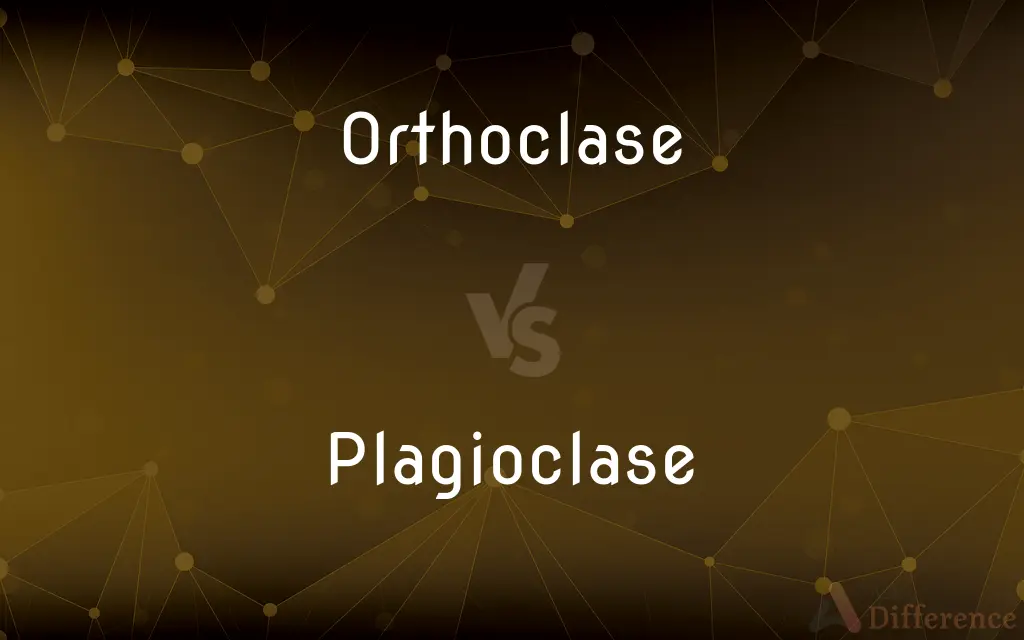Orthoclase vs. Plagioclase — What's the Difference?
By Urooj Arif & Fiza Rafique — Updated on March 14, 2024
Orthoclase is potassium-rich, aiding in granite formation, while plagioclase contains calcium or sodium, key in basalt.

Difference Between Orthoclase and Plagioclase
Table of Contents
ADVERTISEMENT
Key Differences
Orthoclase is a potassium-rich feldspar mineral, contributing to the pink or reddish hue in granite and other rocks. Plagioclase, on the other hand, is a feldspar group that can contain calcium or sodium, playing a crucial role in the composition of basalt and andesite.
Orthoclase's crystal structure allows for a variety of colors, including pink, white, and green, making it a popular choice for gemstones and decorative stones. Whereas plagioclase often appears in white to gray tones, reflecting its different chemical composition.
The hardness of orthoclase on the Mohs scale is around 6, making it durable for use in jewelry and construction. Plagioclase varies in hardness but generally falls within a similar range, making it equally significant in building materials and aggregates.
Orthoclase forms in igneous rocks through the cooling of magma or lava, contributing to the granitic texture. Plagioclase also forms in igneous environments but is more commonly associated with volcanic rocks, indicating a more rapid cooling process.
Cleavage patterns differ between these two minerals; orthoclase typically exhibits two directions of perfect cleavage at right angles, making it distinctive. Plagioclase displays two directions of cleavage at nearly 90-degree angles, with striations on one cleavage face, aiding in its identification.
ADVERTISEMENT
Comparison Chart
Composition
Potassium-rich feldspar
Calcium or sodium feldspar
Common Colors
Pink, white, green
White, gray
Hardness (Mohs)
~6
~6
Typical Formation
Igneous rocks, granite
Igneous rocks, basalt, andesite
Cleavage
Two directions at right angles
Two directions, nearly 90°, with striations
Compare with Definitions
Orthoclase
Potassium-rich feldspar mineral.
The pink hue in the granite is due to orthoclase.
Plagioclase
Feldspar mineral with calcium or sodium.
The light gray stone contained numerous plagioclase crystals.
Orthoclase
Common in granite and pegmatites.
Orthoclase crystals were found embedded in the coarse granite.
Plagioclase
Cleavage planes exhibit striations.
The plagioclase shard revealed striated cleavage faces under magnification.
Orthoclase
Exhibits a range of colors.
The orthoclase specimen displayed a beautiful green tint.
Plagioclase
Predominantly found in basalt and andesite.
The volcanic rock was composed largely of plagioclase.
Orthoclase
Durable, with a Mohs hardness of about 6.
The orthoclase gemstone proved resistant to scratching.
Plagioclase
Typically white to gray in color.
A fine-grained plagioclase lent a grayish tone to the rock.
Orthoclase
Features two perfect cleavage directions.
The orthoclase crystal split along its cleavage planes smoothly.
Plagioclase
Similar hardness to orthoclase, around 6.
The plagioclase feldspar was hard enough to scratch glass.
Orthoclase
Orthoclase, or orthoclase feldspar (endmember formula KAlSi3O8), is an important tectosilicate mineral which forms igneous rock. The name is from the Ancient Greek for "straight fracture," because its two cleavage planes are at right angles to each other.
Plagioclase
Plagioclase is a series of tectosilicate (framework silicate) minerals within the feldspar group. Rather than referring to a particular mineral with a specific chemical composition, plagioclase is a continuous solid solution series, more properly known as the plagioclase feldspar series.
Orthoclase
A white to yellowish red monoclinic mineral of the potassium feldspar group that forms from medium- to low-temperature magmas.
Plagioclase
(mineral) Any of a group of aluminum silicate feldspathic minerals ranging in their ratio of calcium to sodium.
Orthoclase
(mineral) Potassium aluminum silicate, KAlSi3O8, a common feldspar of igneous, plutonic, and metamorphic rocks. Orthoclase is the main feldspar of pegmatite occurrences, where it is most commonly flesh-colored. Orthoclase is used in the ceramic and glass industries and as a decorative gravel.
Plagioclase
A general term used of any triclinic feldspar. See the Note under Feldspar.
Orthoclase
Common or potash feldspar crystallizing in the monoclinic system and having two cleavages at right angles to each other. See Feldspar.
Plagioclase
Any of a rock-forming series of triclinic feldspars
Orthoclase
A white or colored monoclinic feldspar
Common Curiosities
What is orthoclase used for?
Orthoclase is used in ceramics, glass manufacturing, and as decorative stones or gemstones.
Why is orthoclase often pink?
The potassium content in orthoclase contributes to its pink or reddish tint in many specimens.
Is orthoclase suitable for jewelry?
Yes, due to its hardness and color variety, orthoclase is often used in jewelry.
Can the cleavage of plagioclase help in its identification?
Yes, the striations on plagioclase's cleavage planes are a key identifying feature.
What is the significance of orthoclase in ceramics?
Orthoclase's flux properties help in the formation of glass and glazes in ceramics.
What distinguishes plagioclase from other feldspars?
Plagioclase is identified by its calcium or sodium content and striated cleavage planes.
What role do orthoclase and plagioclase play in rock identification?
Their presence and characteristics help geologists identify and classify igneous rocks.
Why is plagioclase important in geology?
Plagioclase's composition and presence in various rocks provide insights into the geological processes and the Earth's crust composition.
How does the chemical composition of orthoclase affect its properties?
The potassium content influences its color, hardness, and melting point.
Can plagioclase be found in granite?
Plagioclase can be a component of granite, but it's more dominant in basaltic rocks.
How do the formation environments of orthoclase and plagioclase differ?
Orthoclase typically forms in cooler, slower cooling environments like granite, while plagioclase forms in a range of environments, often in faster-cooling volcanic rocks.
Are there synthetic forms of orthoclase or plagioclase?
Synthetic forms are rare, as both minerals are abundant in nature.
Is there a gemstone variety of plagioclase?
Yes, some plagioclase varieties like labradorite are valued as gemstones for their unique optical properties.
What is the economic value of plagioclase?
Plagioclase is valuable as an aggregate in construction and as a raw material in industrial processes.
Can orthoclase form in sedimentary rocks?
While rare, orthoclase can appear in sedimentary rocks as detrital grains.
Share Your Discovery

Previous Comparison
Cognition vs. Cognizant
Next Comparison
Flustered vs. FrustratedAuthor Spotlight
Written by
Urooj ArifUrooj is a skilled content writer at Ask Difference, known for her exceptional ability to simplify complex topics into engaging and informative content. With a passion for research and a flair for clear, concise writing, she consistently delivers articles that resonate with our diverse audience.
Co-written by
Fiza RafiqueFiza Rafique is a skilled content writer at AskDifference.com, where she meticulously refines and enhances written pieces. Drawing from her vast editorial expertise, Fiza ensures clarity, accuracy, and precision in every article. Passionate about language, she continually seeks to elevate the quality of content for readers worldwide.














































